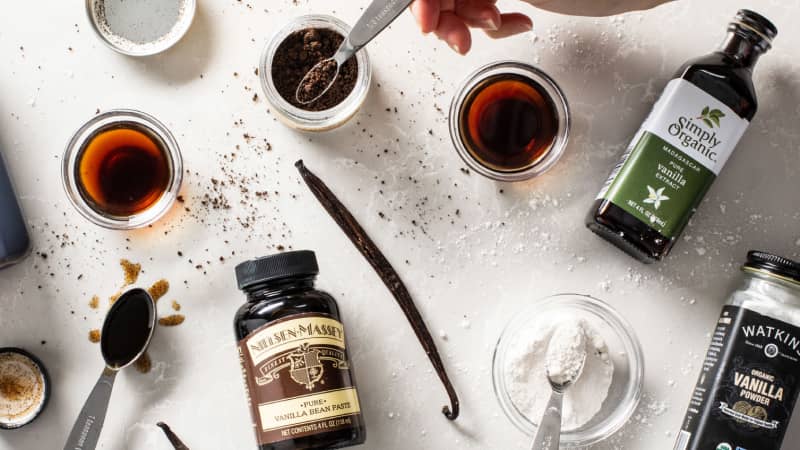Vanilla Ice Cream
Taste Test
Vanilla comes in several forms: liquid, paste, powder, and whole beans. Here’s how and when to use each version of the world’s most popular spice.
Published Dec. 15, 2021. Appears in Cook's Country TV Season 15: Endless Dessert

Over the years the word “vanilla” has become synonymous with “plain” or “boring,” but the actual spice is anything but—it’s bursting with complex flavors. It can taste smoky, spicy, floral, and even fruity given the species, where it’s grown, and how the vanilla beans are cured.
There are two common species of vanilla: Vanilla planifolia and Vanilla tahitensis. V. planifolia is more widely grown and is therefore used in most commercial applications. V. tahitensis is less widely grown, and its flavor is more fruity and floral than the more commonly grown species.
Vanilla flavor varies from region to region as well. According to Tim McCollum, founder and CEO of the vanilla and chocolate purveyor Beyond Good, Madagascar vanilla is what most people imagine when they think of vanilla—full-bodied, rich, and creamy. Mexican vanilla, on the other hand, is "a bit warmer and spicier" than Madagascar, and Tahitian vanilla is "a bit fruitier."
Flavor differences also arise within growing regions based on how the vanilla beans are cured after harvesting. For example, some Mexican vanilla tastes smoky because the pods are cured in wood-fired ovens; some pods are cured in the sun and not smoky at all.
While most home bakers are familiar with the two most common products made from vanilla beans—liquid extract and whole beans—even avid home bakers might not be familiar with three other vanilla products beloved by professional bakers: vanilla paste, ground vanilla, and vanilla powder. We were curious to find the best versions of these products and to learn when and how to successfully use them at home.
First, we conducted tastings to find the best powdered vanilla and vanilla paste. Next, we took the top-rated product in each tasting and compared them with vanilla extract, imitation vanilla extract, and vanilla beans in Chewy Sugar Cookies and Classic Vanilla Pudding in a blind taste test. We used the substitution ratios suggested by manufacturers (when available) and rated each sample on vanilla flavor.
After the sugar rush subsided, we tallied up the scores and made three discoveries: First, each form of vanilla added great flavor to recipes, but their flavors varied from product to product. Second, the prices of the various vanilla products varied widely, too (see “How Do the Prices of Our Winners Compare?”). Finally, most of the products are interchangeable, but we found that ground vanilla and vanilla powder didn't disperse as evenly in wet applications. How and when you use each vanilla product depends on what you're making and your budget. We've compiled our takeaways and suggestions as well as summaries of taster...
The mission of America’s Test Kitchen Reviews is to find the best equipment and ingredients for the home cook through rigorous, hands-on testing.

Carolyn is a senior editor for ATK Reviews. She's a French-trained professional baker.

This is a members' feature.